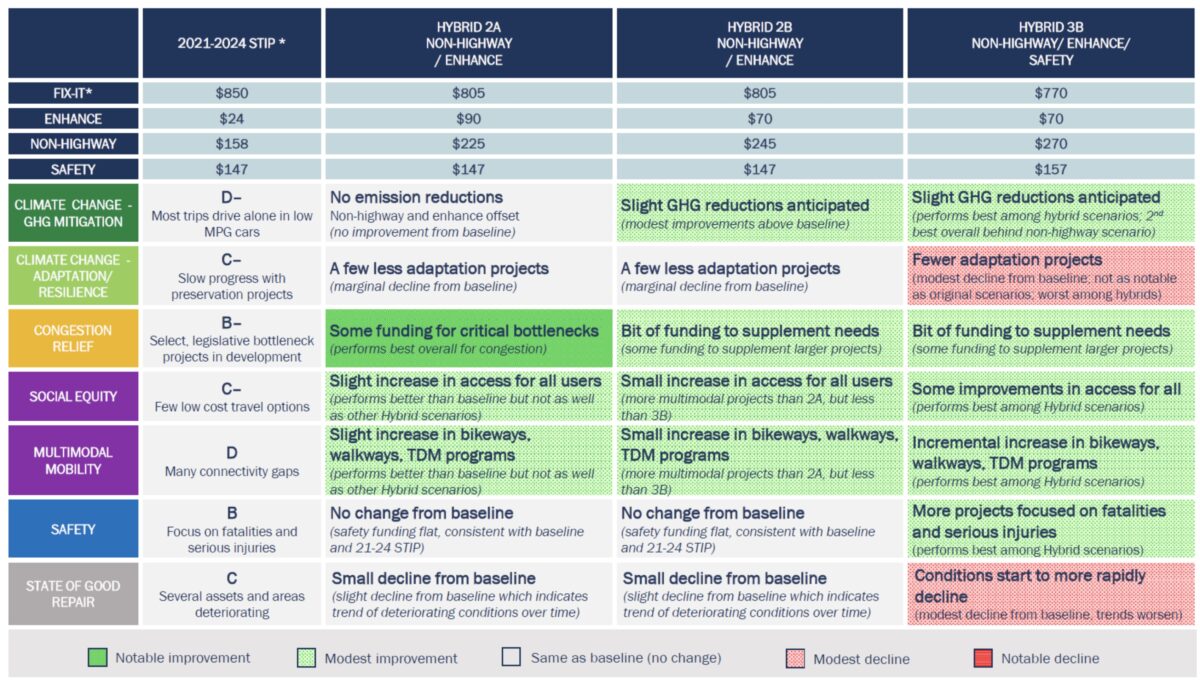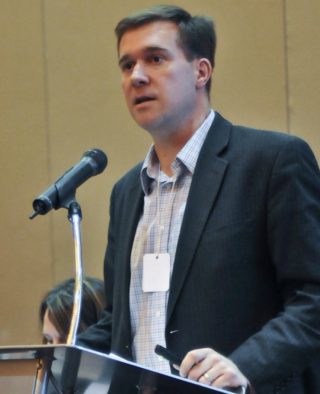
“I would take the win and recognize this is a big step forward for the state.”
— Travis Brouwer, ODOT
A decision that impacts $2.2 billion in transportation spending by the State of Oregon is poised to take a significant step forward on Friday (12/11). As we shared last week, a vote on the Oregon Department of Transportation’s 2024-2027 Statewide Transportation Improvement Program was set to happen December 1st, but was delayed after ODOT staff threw a few curve balls into the process.
After months of public process on four funding “scenarios”, ODOT introduced two new ones just one week ago — the day before the Oregon Transportation Commission (OTC) was going to vote on them. Detailed analysis of the new proposals wasn’t made public until during the OTC meeting just hours before an expected vote. When it was, we realized there were actually four new funding scenarios on the table. This caused a stir both among OTC members who were reasonably overwhelmed at now having eight different scenarios to ponder, and transportation advocates who worried ODOT was trying to rush major changes through without adequate public scrutiny.
Advertisement

This morning Bike Loud PDX launched a “Stop the STIP” campaign, urging people to contact the OTC with concerns about ODOT’s public process and encourage them to devote more funds to the Non-Highway category. Bike Loud also contends that ODOT is not following its own public involvement policy which requires a 45-day public comment period before any “major updates” to the STIP prior to OTC adoption. (ODOT says this policy applies only to STIP adoption, not to minor preliminary steps like this one.)
Before we get into details and dollar amounts, I feel like ODOT has some explaining to do. On that note, this morning I spoke with the man running point for ODOT on this process: Assistant Director for Revenue and Finance Travis Brouwer. Brouwer, who worked in ODOT federal and public affairs before moving into his current role last year, said there’s nothing nefarious going on.

(Photo: Jonathan Maus/BikePortland)
I asked Brouwer how he squares claims of a robust public process with introducing new plans at the last minute. He said changes to the original funding plans were necessary because none of them received a convincing mandate. “The hybrid scenarios were based on the outcome of public comment and are really trying to find a way to incorporate the various major themes from that public comment into a consensus scenario that we thought would have public support,” Brouwer explained.
Pressed on his last-minute actions at the OTC meeting last week, Brouwer acknowledged it was not ideal. “I do agree with you that, ideally, we would have the same amount of time for people to comment on every layer of this,” he said. Brouwer compared these adjustments with the legislative process where a bill is scrutinized by voters and then amended by legislators prior to passage.
The way Brouwer sees it, the changes from the original scenarios to the ones currently on the table are “fairly minor” and are merely attempts to, “smooth out some of the rough edges.” Brouwer felt that one of the major themes from public comment was that more needs to be spent on “Non-Highway” and “Safety” categories — but that it couldn’t come by moving too much out of “Fix-it” and “Enhance” — which in ODOT’s view would hasten deterioration of roads and bridges to unsafe levels.
Last week (12/4), ODOT released a memo (PDF) with the three funding scenarios that will be voted on Friday. The names of the new funding scenarios are: Hybrid 2A Non-Highway/Enhance; Hybrid 2B Non-Highway/Enhance; and Hybrid 3B: Non-Highway/Enhance/Safety. (Note that the five OTC members agreed at their meeting Tuesday (12/1) to discard the original four scenarios and focus on new ones.)

If you’re a fan of the Non-Highway funding category, ODOT’s changes might not feel “fairly minor”. The original Non-Highway funding scenario vetted through months of public process that earned support of advisory bodies and advocacy groups statewide had $320 million of Non-Highway category investment — a 102% increase over the previous STIP. None of the three new Hybrid scenarios come close to that level of Non-Highway funding and represent a decrease of between $69 million (a 42% increase over previous STIP) in Hybrid 3B to $114 million (a 26% increase over previous STIP) in Hybrid 2A compared to the original scenario.
[You can submit comments and testimony on the new scenarios to OTCAdmin@odot.state.or.us before Wednesday (12/9) at 12:00 noon.]
While the Non-Highway funding allocation goes down significantly in the new scenarios, the Fix-it category goes up. It’s still below levels of the previous STIP, but well over any of the four scenarios ODOT originally proposed to the public. The original scenarios would have cut Fix-it by a minimum of 14% compared to the previous STIP. Current Hybrid scenarios would reduce Fix-it spending by just $45 million (5.6%) or $80 million (10%), depending on which one is chosen.
Advertisement

“The STIP is just one of the tools we have to impact climate, and not necessarily even our most effective.”
— Travis Brouwer, ODOT
It’s also glaring that, given the existential crisis posed by climate change, none of ODOT’s proposed funding scenarios would make significant gains in greenhouse gas emission reductions. As you can see in the chart above (a detail of our lead graphic), the Climate Change/GHG Mitigation grade for the current STIP is a D-minus — the lowest grade of all seven measured outcomes (the other being Multimodal Mobility, which gets a D).
“The STIP is just one of the tools we have to impact climate, and not necessarily even our most effective,” Brouwer replied when I asked him about this. He said the agency is working on pricing road use, changing land-use, and boosting transit service. “Ideally, the investments we make in the STIP will allow all those other tools to more effectively address climate,” he added.
Brouwer also downplayed the importance of the STIP when it comes to non-highway funding: “The dedicated, non-highway, state and federal funding in the STIP is only 20% of the total dedicated state and federal non-highway funding we have available, so that’s where you’ve got to look at the rest of the picture, to get a sense of what the total playing field is.”
As for that big picture, Brouwer says people should step back a bit and look at it. “The level of non-highway funding in this STIP, regardless which scenario they select, will be unprecedented,” he said. “It will likely be record levels of non-highway funding, an extra $75 to $100 million.”
Instead of fighting the process, Brouwer says, “I would take the win and recognize this is a big step forward for the state, and that we need to then continue that work at the legislature and other places.”
— The OTC meeting to debate and pass the STIP funding scenarios is set for 8:00 am on Friday. Comments and testimony are accepted via email to OTCAdmin@odot.state.or.us before Wednesday (12/9) at 12:00 pm. Hear more from Brouwer in a segment on OPB’s Think Out Loud radio show that aired today (12/7).
— Jonathan Maus: (503) 706-8804, @jonathan_maus on Twitter and jonathan@bikeportland.org
— Get our headlines delivered to your inbox.
— Support this independent community media outlet with a one-time contribution or monthly subscription.

